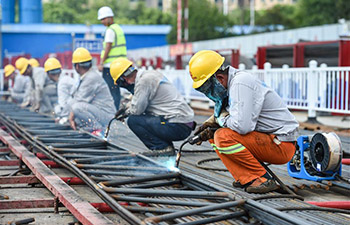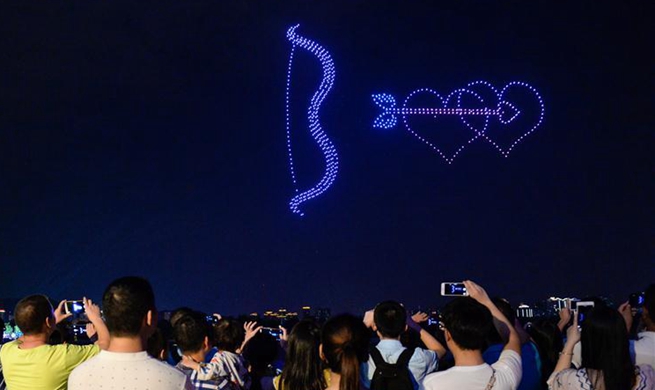By Alessandra Cardone
GENOA, Italy, Aug. 17 (Xinhua) -- Three Days after the collapse of a major bridge that killed dozens in the northwest Italian city of Genoa, authorities were mulling two solutions to try to minimize the effects of the disaster in the short and medium term.
On one hand, alternative routes are needed to divert heavy vehicles headed to port from passenger traffic. On the other hand, the city plans to build a new viaduct in the place of the fallen one in two years.
On Tuesday, the mid-section of a 1,182-meter viaduct called Morandi Bridge -- linking Genoa west and east, and leading to two major highways -- suddenly collapsed, sending dozens of cars and trucks falling some 45 meters to the ground.
As of Friday, the death toll was 38 -- revised from previous 39 -- while 15 wounded people remained in hospital, according to the local prefecture.
The figure was provisional, and the chief prosecutor investigating into culpable disaster and culpable manslaughter, Francesco Cozzi, suggested up to 10-20 people could still be missing.
POSSIBLE CONSEQUENCES
The city of Genoa -- some 580,000 inhabitants, and the premier container port of Italy -- was deeply wounded by the tragedy.
The bridge collapse has severely maimed the city's complex viability system, depriving it from a major artery towards port areas.
"In the short term, we could have a drop up to 10 percent of the goods volume annually exchanged in the two port basins of Genoa," Paolo Signorini, chairman of the Western Ligurian Sea Port Authority, told Xinhua.
The Authority jointly manages the ports of Genoa, Savona, and Vado in the Liguria region.
"We might estimate a loss up to 10 percent of the value added taxes and excises annually produced by our port system, which amounted to some 6 billion euros (6.8 billion U.S. dollars) in latest years," Signorini said.
Yet, local authorities stressed the city was "not on its knees", and would be able to react.
"Beyond the psychological blow to our people, we must focus on one thought: rising again after such tragedies is possible," Genoa mayor Marco Bucci stressed in an interview with Xinhua.
The official said viability must be restored as soon as possible, finding a swift alternative path for the traffic previously passing through the collapsed bridge, and especially for heavy goods vehicles headed to the port.
Time for avoiding the city being congested was short: the first week of September, at latest, Genoa would return to its usual, intense life.
"Practically speaking, the bridge collapse has deprived the city of four carriageways," the mayor explained.
"If we are able to open the two alternative routes we are thinking of -- using private roads -- we will have six lanes instead."
NEW ROUTE FOR GOODS VEHICLES
The Liguria region's port system made of Genoa, Savona, and Vado harbors is one major gateway port to Southern Europe, and the Rhine-Alpine Corridor's last Mediterranean port of call.
Genoa alone has two major port basins, namely Sampierdarena and Voltri.
"Genoa registers daily movements of some 8,000 heavy goods vehicles in its two basins of Voltri and Sampierdarena, including exports and imports," the Port Authority chief explained.
"Approximately, we estimate 1,500 of such vehicles used the Morandi Bridge daily," Signorini said.
With Genoa's existing viability, such freight transport would naturally flow into the waterfront before the port areas, and that, according to Signorini, was "unconceivable, and impractical".
The major alternative that municipality, Liguria region, and port authority together were planning would involve adjacent roads.
"Our solution would focus on existing arteries within an area managed by (steelwork company) ILVA and a neighboring state-property area," the chairman explained.
"These two areas are already connected by a bridge, and directly reach the port."
Mayor Bucci sounded confident such route could be open by around Aug. 26, while the Port Authority chairman was more prudent, saying such solution was "in an advanced stage".
"After such a shocking event like the bridge collapse, the most crucial thing is to provide the city with a feasible and clear plan in the next few days," Signorini stressed.
"We must be able to tell people of Genoa and economic operators that a well-defined project is ready, and can be put in place in a matter of some weeks ... and our plan is indeed possible," he added.
This would partially counter-balance the lack of the collapsed viaduct in the short period, accepting that minor traffic disruption might still occur.
In the medium term, the mayor of Genoa said the goal was to rebuild the collapsed bridge.
"Without being too optimistic, I think this can be done over a period of two years," Bucci told Xinhua.
"We are thinking about a steel structure, and discussing the idea with our technical staff. There seem to be good chances."
The costs for such a project, the mayor said, could not be estimated yet.
IMPLICATIONS AT NATIONAL LEVEL
Beyond its vital role for Genoa, the Morandi Bridge was inserted in a viability system crucial for the whole northwest Italy. Finding a solution after Tuesday's disaster was therefore relevant at national level as well.
Before collapsing, in fact, the viaduct carried the A10 highway running along the coastline to France, and it received traffic flows from the A26 highway coming from northwest Piedmont region, and from the A7 highway connecting to Italy's major economic hub Milan.
The A26 and A7 respectively lead to Voltri and Sampierdarena port basins.
The possible wider impact of the bridge is also linked to the relevance of the port system. Some 69 million tonnes of cargo are annually handled in Genoa's 30 specialized terminals -- with China alone accounting for about 35 percent of such volume -- according to the Port Authority.
Over 4 million people every year choose the three ports (Genoa, Savona, and Vado) as departure points for their trips every year.
Finally, a study carried out by consulting institutes Nomisma, Prometeia, and Tema in 2016 showed Genoa's port supply chain provided at least 28,000 direct jobs, producing 6.89 billion euros in annual turnover, and 2.78 billion in value added.
Including indirect effects -- for example, purchases of goods and services in other sectors -- and induced impact, the research estimated a total of 54,000 employees, some 10.84 billion euros in turnover, and 4.63 billion in value added. (1 euro = 1.14 U.S. dollars)













